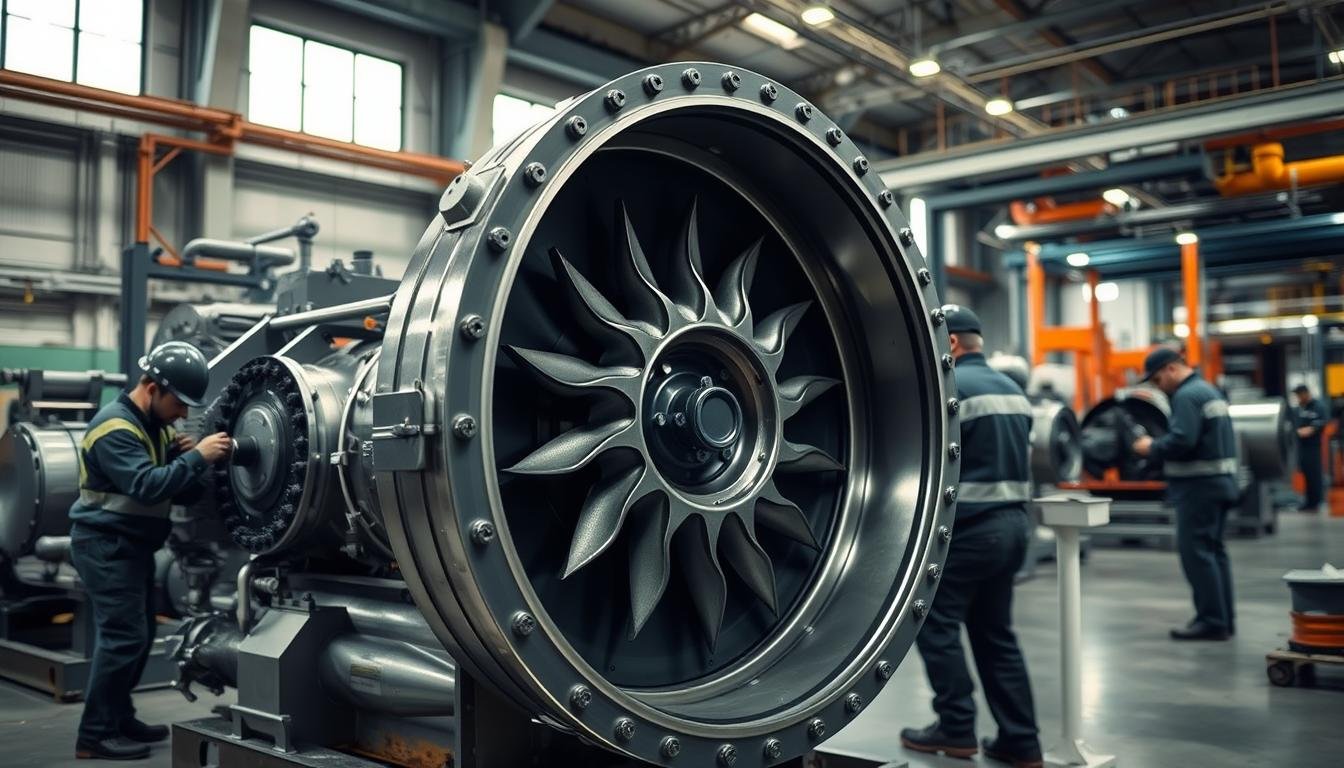Centrifugal compressors are key in many industries. They turn kinetic energy into pressure energy. This is important for refrigeration, air conditioning, and gas turbine engines.
Understanding how these machines work is essential. It helps keep them running well and for a long time. Taking good care of them makes them more efficient and reduces downtime.
This article will cover how to build and maintain centrifugal compressors. You’ll learn how to keep your system reliable and running smoothly.
Understanding the Basics of Centrifugal Compressors:
Centrifugal compressors are amazing machines that use centrifugal force to increase gas energy. They are key in many areas, like gas turbines and refrigeration systems. The process starts with drawing in air or gas, then compressing it with rotating impellers, and pushing it out at a higher pressure.
This process shows how engineering and fluid mechanics work together. It’s all about making the compressor efficient and effective.
Fluid mechanics is vital for understanding how well a compressor works. Things like pressure, temperature, and flow rate matter a lot. By looking at these, we can see if a compressor can handle the job it’s given.
This focus on these factors shows how important design is for a compressor’s success. It’s all about making sure the compressor does its job well in different situations.
Key Components of a Centrifugal Compressor:
Understanding the key parts of a centrifugal compressor is key to its efficiency. The impellers are at the heart of this system. They turn the rotational energy into pressure energy. As gas enters the impeller, it speeds up due to centrifugal force.
This fast gas then moves to the diffusers. The diffusers slow down the gas, increasing its pressure. This is vital for the compression process. The volute casings then hold the compressed gas, guiding it to the discharge area. The design of these casings greatly affects the system’s efficiency.
The materials used for these parts are also critical. They must handle high pressures and temperatures without wearing out. Each part, from impellers to casings, must work together for the best performance and reliability.
Centrifugal Compressor Design Considerations:
In my study of centrifugal compressor design, I found that aerodynamic design is key. The shape of the blades is vital for air flow. A well-designed blade improves performance and cuts energy use, boosting efficiency.
The number of stages in a compressor matters too. Each stage helps build pressure and manage airflow. Knowing the compressor’s intended use is critical for its efficiency and reliability.
A strong design is essential for handling operational stresses. New design technologies have made compressors more functional and longer-lasting. By understanding these design elements, we can build efficient and reliable machines for different industries.
Construction Process of Centrifugal Compressors:
The making of centrifugal compressors is a detailed process. It includes steps like casting, machining, and assembly. These steps are key to making a strong and reliable compressor.
First, I choose high-quality materials for the compressor parts. This step is very important. It affects how well the compressor works and lasts.
After that, I carefully shape and size the parts. This ensures they fit perfectly and work well together. I check each part carefully to catch any problems early.
Safety is always my top priority. I follow all safety rules and regulations. This keeps the compressor safe and working well.
Every step, from making the parts to putting them together, shows my dedication. I aim for the best in making centrifugal compressors.
Maintenance Practices for Optimal Performance:
Keeping centrifugal compressors in top shape is key. I make sure to do regular checks and spot any problems early. This includes looking for wear, checking oil levels, and watching for vibrations.
Regular checks are also important. I test how well the compressor works and check its efficiency. This helps me catch and fix issues before they get worse. By being proactive, I can make my compressors last longer and work better.
Common Issues and Troubleshooting:
Working with centrifugal compressors means knowing about common problems. These include airflow issues, vibration, and overheating. These issues can cause big problems if not fixed fast. I’ve learned that finding and fixing these problems early is key.
Airflow problems often come from dirty filters or blockages. It’s important to check and clean these parts often. Vibration can mean something’s not right with alignment or wear. Using tools like vibration analysis helps find and fix these issues quickly.
Overheating can happen if there’s not enough lubrication or too much load. Keeping an eye on temperatures and making sure lubrication works right is important. By using these methods, we can avoid big problems and make compressors work better.
Importance of Professional Support and Services:
Getting professional help for your centrifugal compressors is key. Experienced techs offer insights for installation and upkeep. They can spot problems early, stopping small issues from becoming big ones.
Having maintenance support means your compressor runs right. It’s more reliable and efficient. Using pros means following the best practices, making your work smoother.
Working with skilled techs helps you manage your compressor system better. They know how to solve tough problems, keeping your system running well for years.
Future Trends in Centrifugal Compressor Technology:
The future of centrifugal compressor technology is exciting. The industry is set for big changes. New materials are being developed to make compressors last longer and weigh less.
These advancements lead to better efficiency and lower costs. They are key for businesses to stay ahead in today’s fast-paced market.
Automation is also playing a big role in these changes. Automated systems help monitor and adjust performance in real-time. This reduces mistakes and makes processes smoother.
It shows a move towards smarter manufacturing. Digital technologies, like the Internet of Things (IoT), are also important. IoT helps with predictive maintenance and monitoring.
It lets me spot problems before they happen. By keeping up with these trends, I can make sure my compressors work well for a long time.
